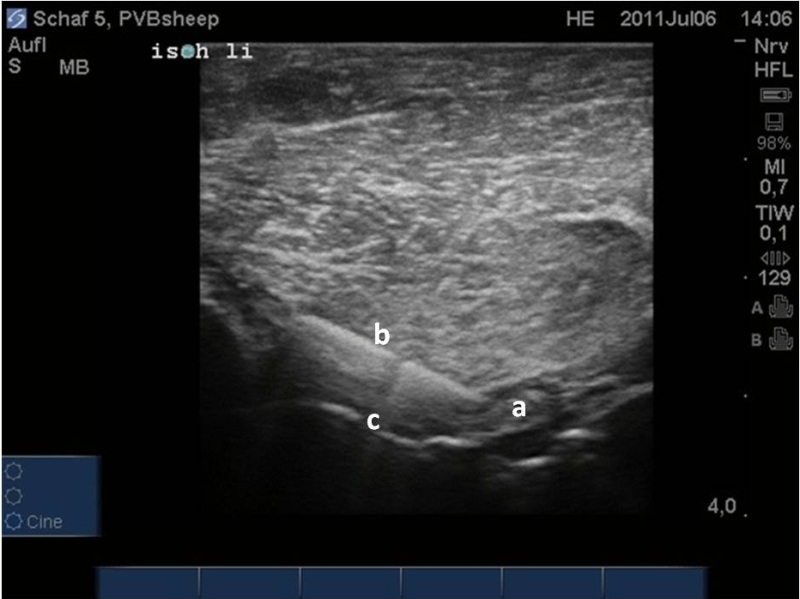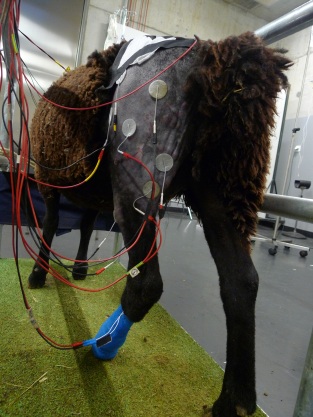 |
de | fr | en Druckansicht ![]()
3R-Project 122-10
Improved perioperative analgesia and reduced stress during recovery for the experimental animal: ultrasound-guided sciatic and femoral nerve block in sheep and quantitative assessment of block quality
Helene Rohrbach1 and Urs Eichenberger2
1Institute for Anaesthesiology and Pain Therapy, Vetsuisse Faculty, University of Bern, 3012 Bern, Switzerland
2Department of Anaesthesiology and Pain Therapy, Bern University Hospital and University of Bern, Inselspital, 3010 Bern, Switzerland
helene.rohrbach@vetsuisse.unibe.ch, urs.eichenberger@insel.ch
Keywords: sheep; animal welfare; mechanobiology; orthopedics; pain / stress; animal welfare; refinement
Duration: 3 years Project Completion: 2014
Background and Aim
Due to a lack of alternative methods, sheep are widely used for biomechanical research purposes, e.g. for studies concerning the knee joint. Until now, sheep have usually received a combination of analgesics at the time of induction of anaesthesia and again during the post-operative phase by intravenous or intramuscular injection. Based on knowledge of surgery in other species, the assumption may be made that such treatment might be insufficient and these sheep may still feel severe pain.
Regional anaesthesia as an adjunct to general anaesthesia may markedly improve the wellbeing of these experimental animals during the post-operative period [1, 2]. A possible side effect of neuraxial (spinal or epidural) anaesthesia is a bilateral blockade of motor fibres beside the blockade of sensitive fibres. Especially in flight animals, as sheep are, this bilateral paralysis may again cause severe distress. Treating only one side – the side of surgery – using peripheral perineural administration of local anaesthetics helps to prevent this source of stress. The reliability of peripheral perineural blockade can be increased by reducing the failure rate if performed using ultrasound guidance. [3].
Species-specific quantification of post-operative pain is mandatory to evaluate the efficacy of the analgesic technique used. In sheep, as in other flight animals, pain recognition and quantification are particularly difficult. The nociceptive withdrawal reflex (NWR) has been extensively used for the study of experimental nociception in animals and humans [4, 5]. A close relationship between pain threshold and NWR threshold has been identified [6, 7].
Behavioural pain assessment combined with the evaluation of mechanical and thermal nociceptive thresholds in the operated area and a quantification of the NWR will provide a complete way to assess the efficacy of the proposed local anaesthetic technique.
Method and Results
in progress (present status)
The technique of ultrasound-guided blockade of the sciatic and the femoral nerves has been modified and adapted to the ovine anatomy. First, the method was tested in sheep cadavers. In a next step, blockade of the sciatic nerve and the placement of a perineural catheter under sonographic control were evaluated in healthy sheep. The repeated evaluation of the NWR in combination with tests of cutaneous sensation and a determination of the motoric function of the limb allowed an adequate evaluation of quality and duration of loss of sensation after perineural injection of ropivacaine to the target nerve. The duration of effect was longer than expected but the animals could cope with the loss of sensation as well as the motoric function after some time of adaptation.
The clinical application of the method remains to be performed in sheep undergoing invasive hind limb surgery.
Conclusions and Relevance for 3R
If we are successful in the description and optimization of ultrasound-guided single shot and catheter-based sciatic-femoral nerve blocks in sheep, these techniques may become standard treatment for hind limb surgeries in experimental sheep to provide efficacious intra and post-operative analgesia. Due to the remote location from the surgical area, regional anaesthesia techniques will not influence the surgical procedure.
References
1. Troncy, E., et al., Results of preemptive epidural administration of morphine with or without bupivacaine in dogs and cats undergoing surgery: 265 cases (1997-1999). Journal of the American Veterinary Medical Association, 2002. 221(5): p. 666-672.
2. Adami, C., et al., Sciatic-femoral nerve block with bupivacaine in goats undergoing elective stifle arthrotomy. Vet J., in press
3. Abrahams, M.S., et al., Ultrasound guidance compared with electrical neurostimulation for peripheral nerve block: a systematic review and meta-analysis of randomized controlled trials. Br. J. Anaesth., 2009: 102(3):408-417.
4. Chan, C.W. and M. Dallaire, Subjective pain sensation is linearly correlated with the flexion reflex in man. Brain Res, 1989. 479(1): p. 145-50.
5. Spadavecchia, C., et al., Comparison of nociceptive withdrawal reflexes and recruitment curves between the forelimbs and hind limbs in conscious horses. Am J Vet Res, 2003. 64(6): p. 700-7.
6. Rohrbach, H., et al., Comparison of the effects of the alpha-2 agonists detomidine, romifidine and xylazine on nociceptive withdrawal reflex and temporal summation in horses. Vet Anaesth Analg, 2009. 36(4): p. 384-95.
7. Bergadano, A., et al., Plasma levels of a low-dose constant-rate-infusion of ketamine and its effect on single and repeated nociceptive stimuli in conscious dogs. Vet J, 2009. 182(2): p. 252-60.
Figures

Figure 1: Ultrasonographic image of the left sciatic nerve (a). The position of the needle tip was identified on the basis of reflector marks. (b) Ultrasound needle with its reflector mark (c) Ilium.
Figure 2
Sheep with a catheter at the sciatic nerve an EMG electrodes at 4 muscles of the left hind limb.

Figure 2
| Letzte Änderung: 12.10.2018 |